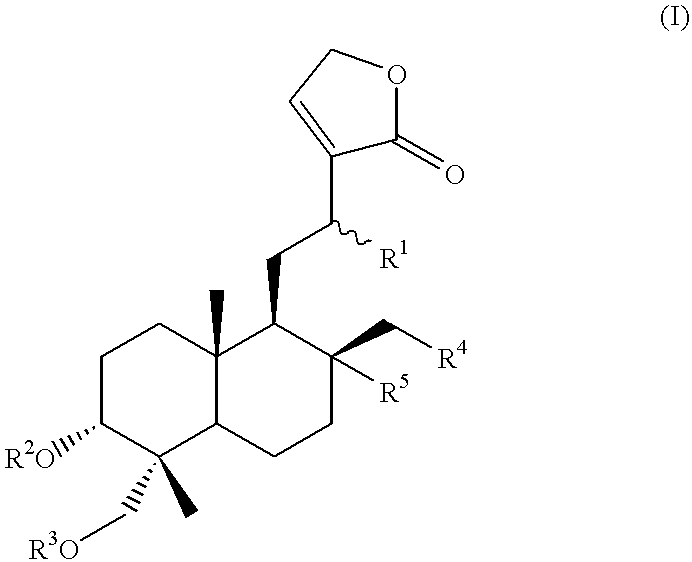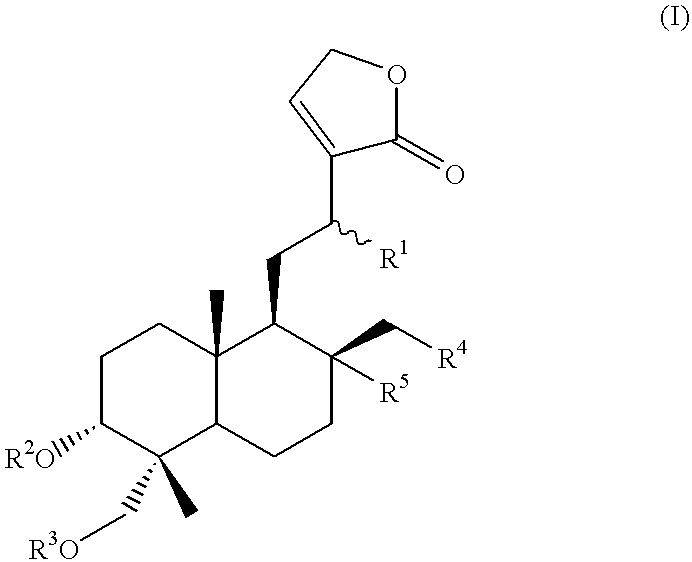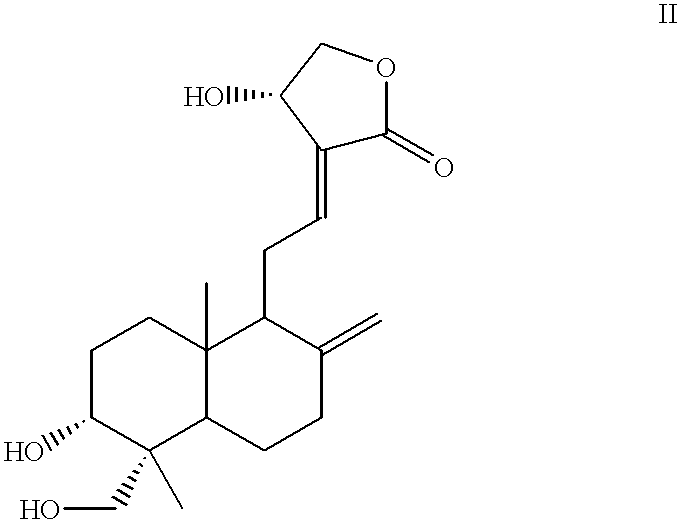Compounds having anticancer activity : process for their preparation and pharmaceutical compositions containing them
a technology which is applied in the field of compound and anticancer activity : process for their preparation and pharmaceutical compositions containing it, can solve the problems of not showing interesting activity, tumor development and other proliferative disorders, etc., and achieves no toxic effect, enhanced activity, and reduced toxic effect
- Summary
- Abstract
- Description
- Claims
- Application Information
AI Technical Summary
Benefits of technology
Problems solved by technology
Method used
Image
Examples
example 2
14-Deoxy-12-(O-methylphenylglycino)-3,19-O-(1-phenylethylidene) androgrpaholide
##STR38##
To a suspension of 14-acetyl-3,19-O-(1-phenylethylidene)andrographolide (2.2 g, 4.45 mmols) in diethyl ether (100 ml), methyl ester of phenyl glycine (1.84 g, 11.1 mmols) was added dropwise and the contents were stirred at room temperature for 5 h. The reaction was monitored by TLC. After completion of the reaction, the reaction mixture was diluted with diethyl ether, washed thoroughly with water, dried over Na.sub.2 SO.sub.4 and concentrated. The residue was purified by flash chromatography over a column of silicagel (230-400 mesh) with light petrol:ethyl acetate (82:18) as solvent system to obtain the title compound as a colourless solid (1.6 g ). m.p. 91.degree. C., m / z 599.
.sup.1 H NMR(CDCl.sub.3): .delta.7.45-7.2(m), 7.1(s), 4.8(s, 2H), 4.65(s, 1H, H-17a), 4.35(s, 1H, H-17b), 4.0(d, 1H, H-19a), 3.6(s, 3H), 3.45(dd), 3.2(dd, 1H), 1.45(s, 3H), 1.2(s, 3H), 0.3(s, 3H).
examples 3-26
have been prepared by using similar procedures described in Examples 1 & 2.
example 27
3,19-Diacetyl-14-deoxy-12-(N-1,2,4-triazolyl)androaapholide
##STR63##
A mixture of 3,14,19-triacetyl andrographolide (500 mg, 1.05 mmol) (Ref: Journal of Chemical Society, 1952, p-1697-1700) and 1,2,4 triazole (220 mg, 3.18 mmol) in DMF(10 ml) were heated to 100.degree. C. and the heating continued for 1 h. The reaction was monitored by TLC. After completion of the reaction, the reaction mixture was poured into water, extracted with diethyl ether and dried over Na.sub.2 SO.sub.4. The residue obtained after removal of the solvent was flash chromatographed over a column of silica gel (230-400 mesh) with chloroform:methanol (99.5:0.5) as the eluting system to get the title compound as a colourless solid (200 mg). m.p. 129.degree. C., m / z 485.
.sup.1 H NMR (CDCl.sub.3): .delta.8.2(s), 7.9(s), 7.6(s), 5.3(dd), 4.9(m, 3H), 4.5(s, 2H) 4.4(d, 1H, H-19a), 4.1(d, 1H, H-19b), 2.6(t), 2.4(m), 2.0(s, 6H), 1.0(s, 3H), 0.7(s, 3H).
PUM
| Property | Measurement | Unit |
|---|---|---|
| concentration | aaaaa | aaaaa |
| temperature | aaaaa | aaaaa |
| temperature | aaaaa | aaaaa |
Abstract
Description
Claims
Application Information
 Login to View More
Login to View More - R&D
- Intellectual Property
- Life Sciences
- Materials
- Tech Scout
- Unparalleled Data Quality
- Higher Quality Content
- 60% Fewer Hallucinations
Browse by: Latest US Patents, China's latest patents, Technical Efficacy Thesaurus, Application Domain, Technology Topic, Popular Technical Reports.
© 2025 PatSnap. All rights reserved.Legal|Privacy policy|Modern Slavery Act Transparency Statement|Sitemap|About US| Contact US: help@patsnap.com



